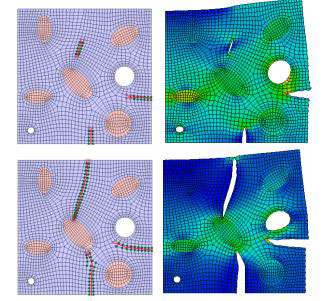Modeling, Diagnosis and Propagation of Discontinuities
Columbia University
Problems
Traditional finite elements are limited in the modeling of weak discontinuities (e.g. multiphase materials) or strong discontinuities (e.g. cracks) as the mesh generated has to conform to the internal boundaries of these discontinuities. Moreover, when these cracks propagate in the domain, or when one solves repeated problems involving discontinuities (e.g. as part of a Monte Carlo process), then re-meshing the domain becomes non trivial, especially in 3D. This motive repeats for many important problems in Engineering Mechanics. Consider the example of nondestructive flaw detection in Structure Health Monitoring. NDE based computational methods are very attractive as they can assess flaws without disassembling or damaging the structure in the process. They are structured as inverse problems in which measurements of system variables such as strains may be available, while the physical properties of the system itself are unknown. Typically, the solution of inverse problems consists of an iterative process with multiple solutions of a changing forward problem that has to be solved within some minimization algorithm. Hence by minimizing the error between the predicted and measured quantities, it is expected that the iteration will converge to the true flaw. However, these algorithms can routinely converge to a local minimum, which may be far from the true solution, and may also take a large number of iterations. When cracks are broadly defined as damage zones in structures, the geometry of the forward problem remains unchanged and iterations are simply repeated with mesh refinement. This process - usually addressed in the literature as parameter estimation or identification - results in a crude estimation of flaw location and size.
Approach
The limitations of FEM in modeling, diagnosis and propagation of weak and strong discontinuities can be circumvented by extended finite element techniques. The key idea of XFEM is to locally enrich the standard FE approximation with local partitions of unity enrichment functions, which are chosen according to the physics of the problem at hand. These functions are capable of generating discontinuities and hence the meshing limitations of FEM are alleviated.

Findings
The extended finite element method is implemented within a Genetic Algorithm framework and applied to the detection of cracks and holes. It is shown that with a versatile elliptical hole formulation in XFEM any flaw type may be approximated by minimizing the error between the simulated data and sensor measurements. Hence for arbitrary shaped damage, the algorithm converges to the "best" approximating elliptical hole. The methodology has been validated numerically and experimentally on different flaw types and was shown to provide relatively accurate results, given that sufficient number of sensors is employed.
Impact
The extended finite element method offers significant advantages in the modeling of discontinuities at different scales. It may be coupled with optimization methods (e.g. for flaw detection), Monte-Carlo methods (e.g. for uncertainty quantification), or may simply be employed to improve our understanding and modeling capabilities of fracture mechanics techniques.
Core competencies
- Systematic modeling of discontinuities by Extended Finite Element Methods
- Multiscale methods for bridging the time and length scales in material modeling
- Simplified contact-friction models for suspension bridges main cables
- Computational nanomechanics
- Methods for shear band modeling
- Multigrid methods, iterative solvers and parallel computing
Current research team members
- Haim Waisman (PI)
- Ravindra Duddu (Postdoctoral Fellow)
- Badri Hiriyur (Ph.D. Candidate)
- Xia Liu (Ph.D. Candidate)
- Arturo Montoya (Ph.D. Candidate)
- Mengyu Lan (Ph.D. Candidate)
- Colin McAuliffe (Ph.D. Candidate)
- Luciana Balsamo (Ph.D. Candidate)
- Brett Benowitz (Ph.D. Candidate)
- Reza Yaghmaie (Ph.D. Candidate)
- Weizhi Shao (Ph.D. Candidate)
Former research team members
- Luc Berger-Vergait (M.S), currently at INSA, France
- Eleni Chatzi (Ph.D.), Assistant Professor at ETH, Switzerland
Current research collaborations
- Raimondo Betti, George Deodatis, Andrew Smyth, Jacob Fish and David Keyes at Columbia University
- Ray Tuminaro and Erik Boman at Sandia National Labs


